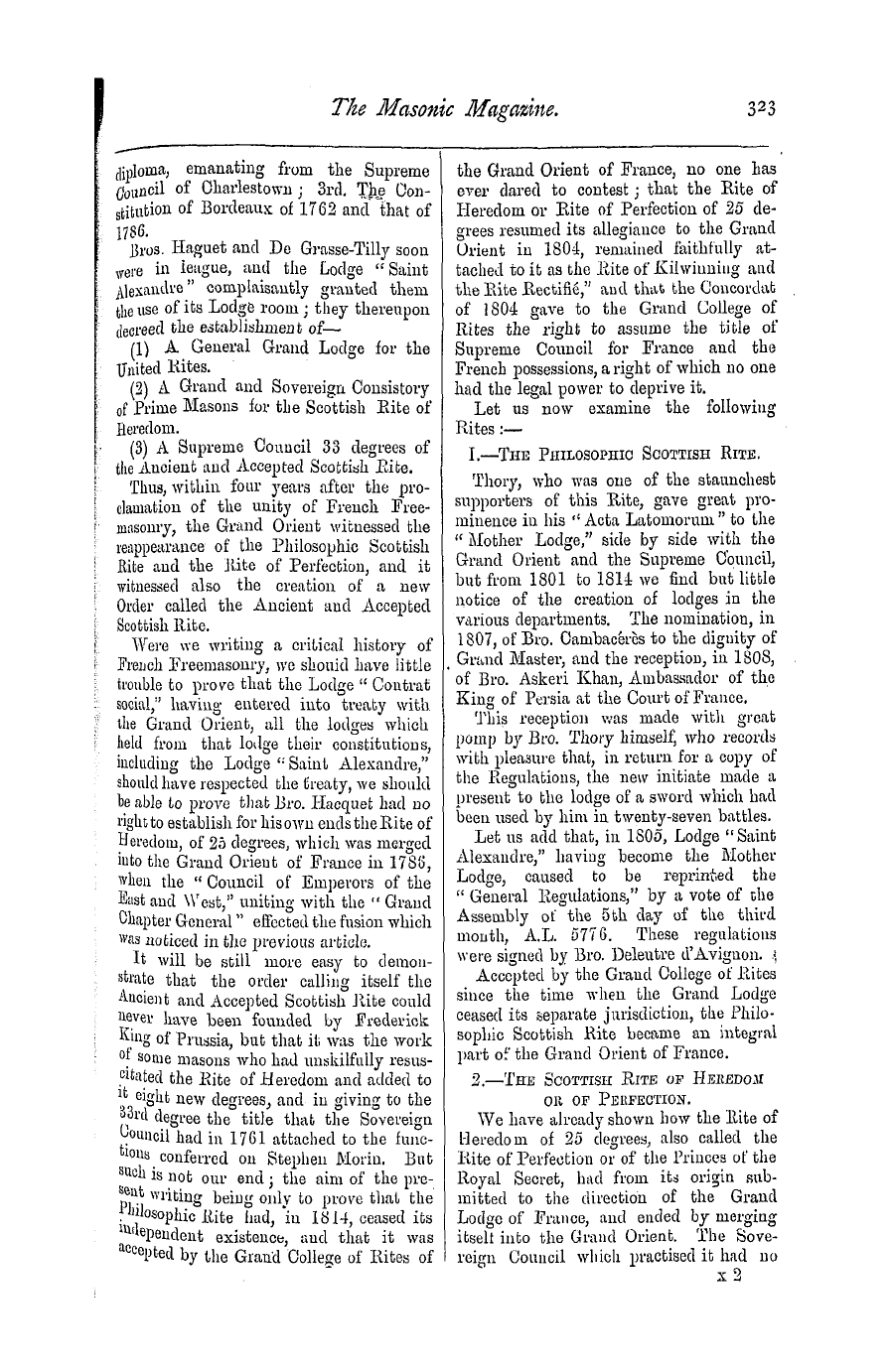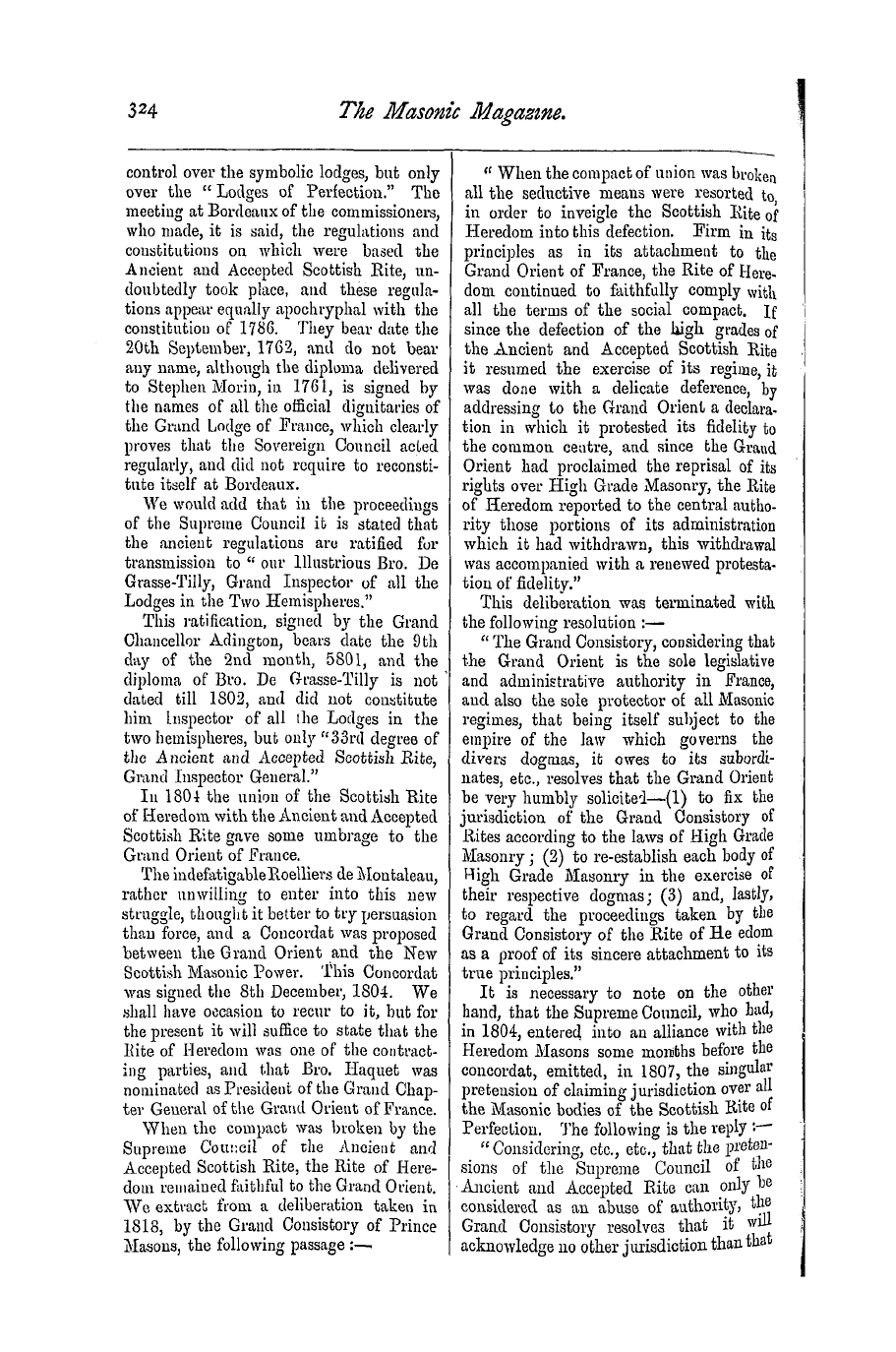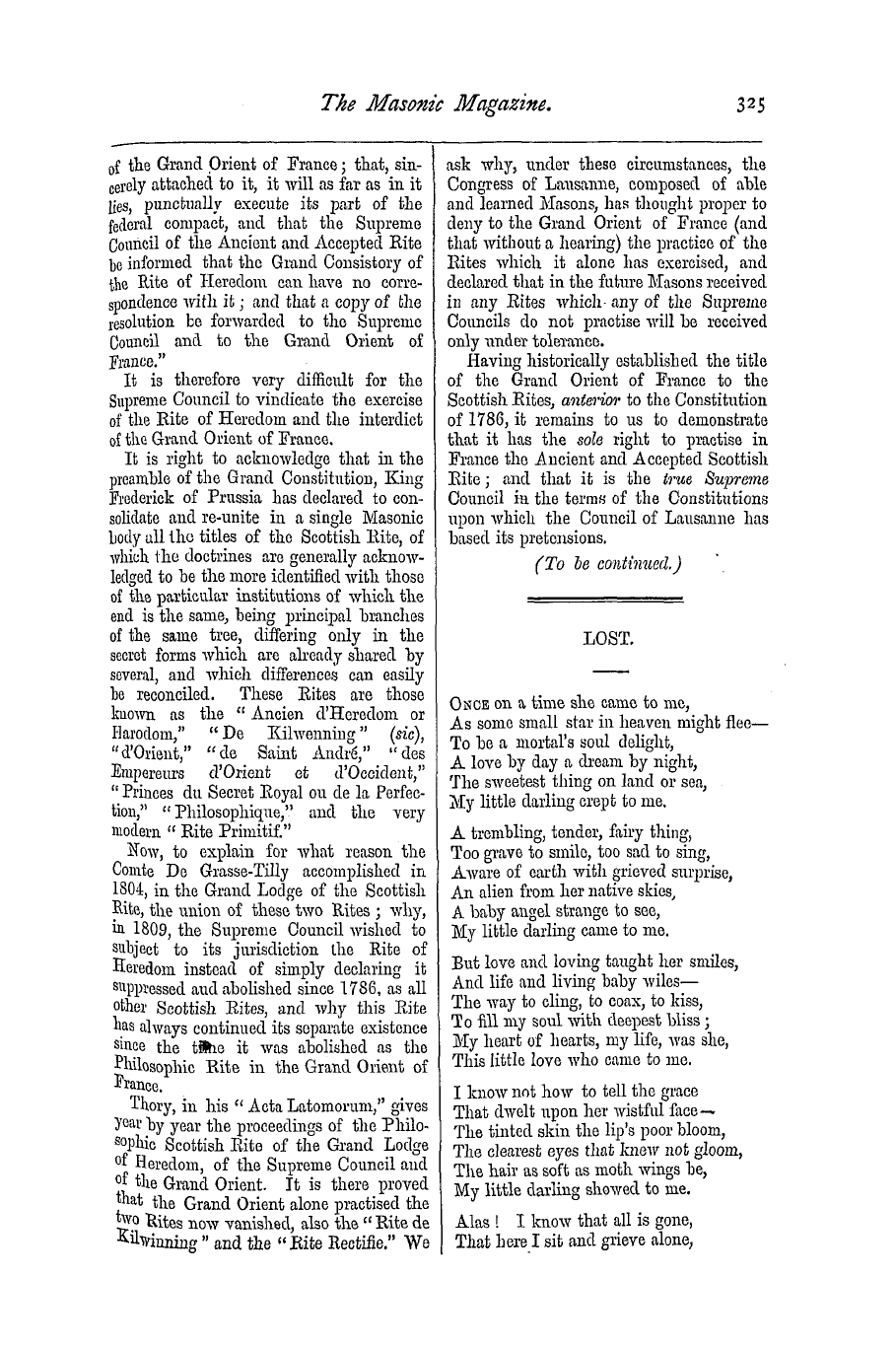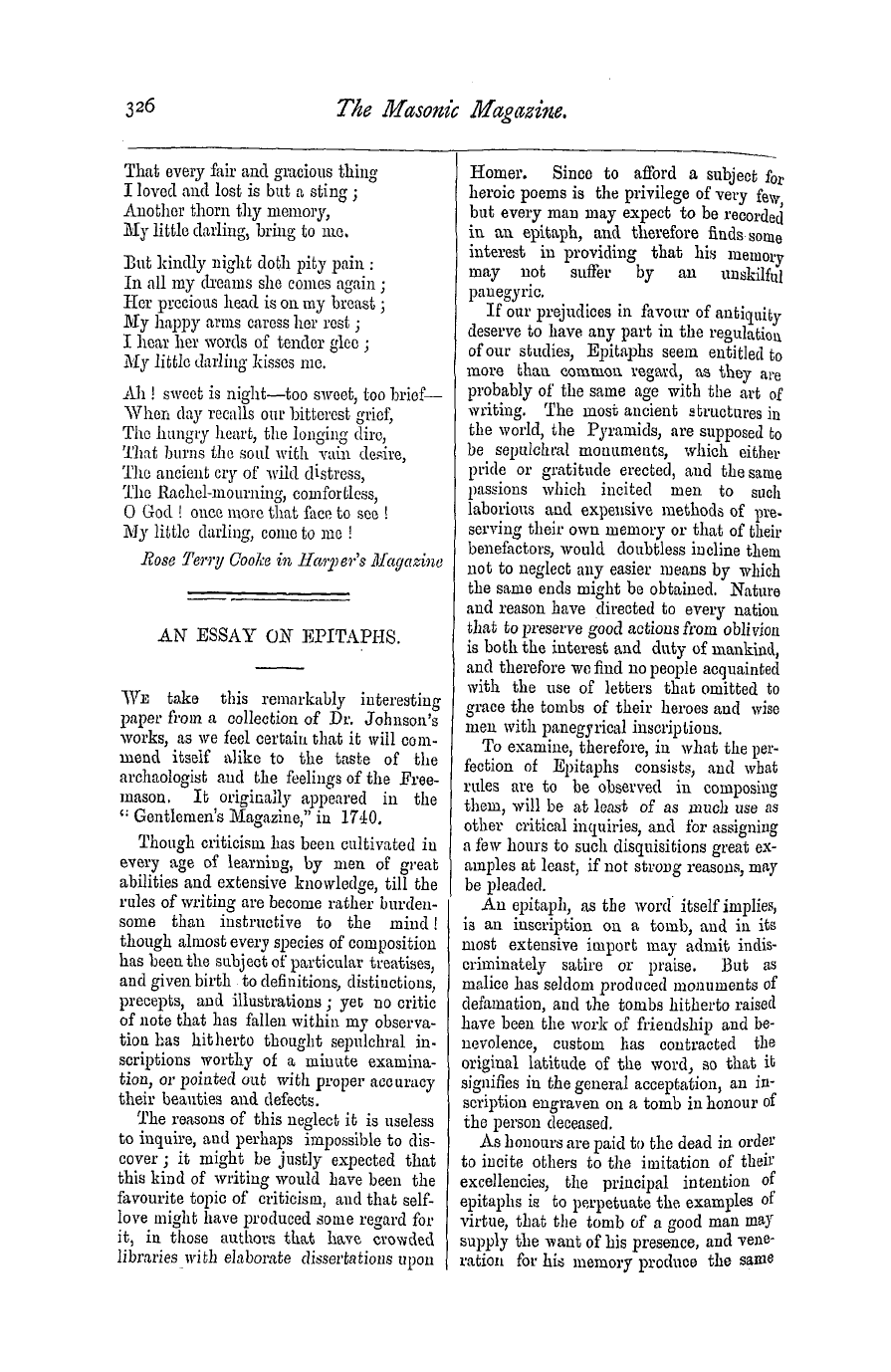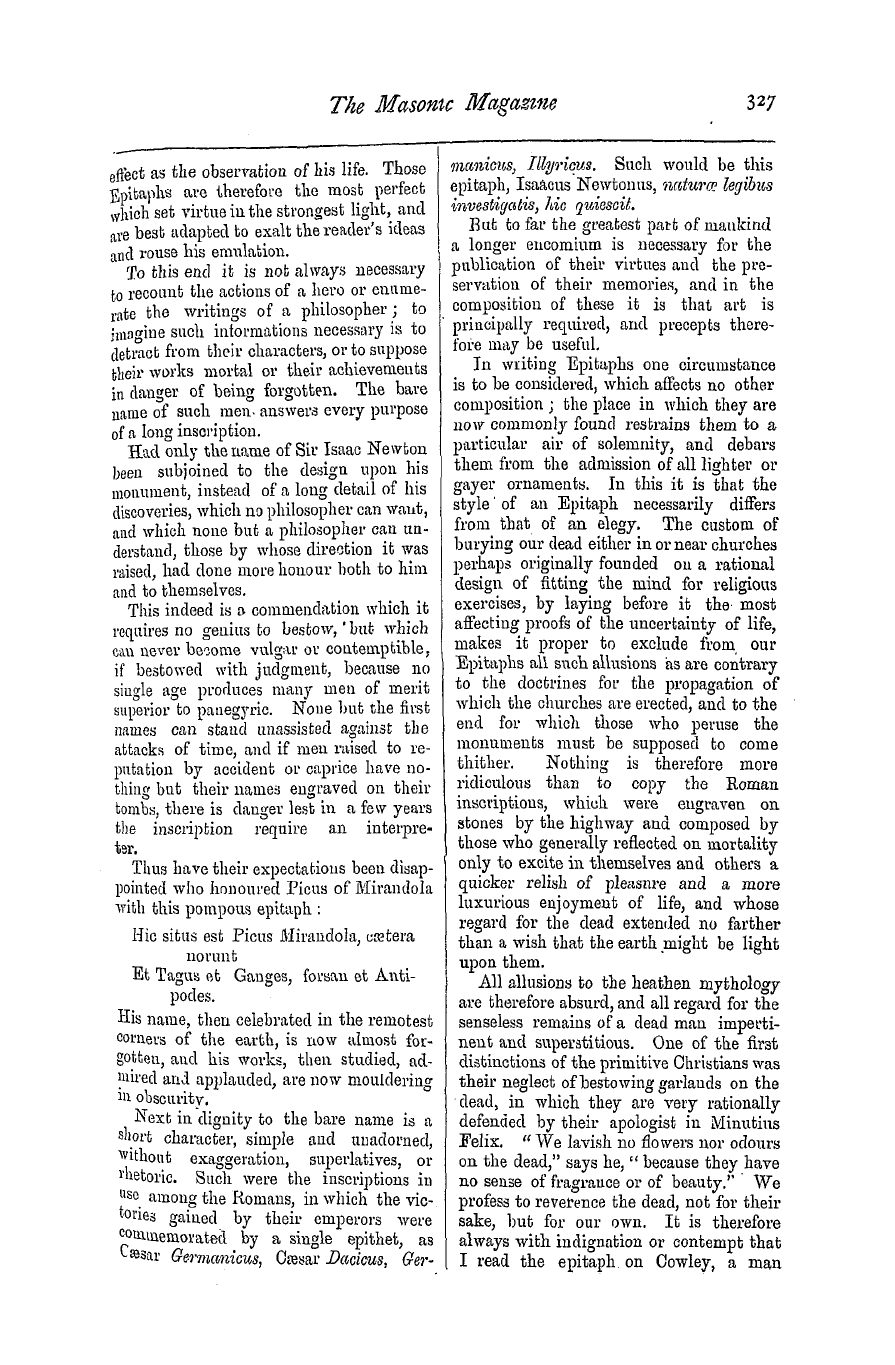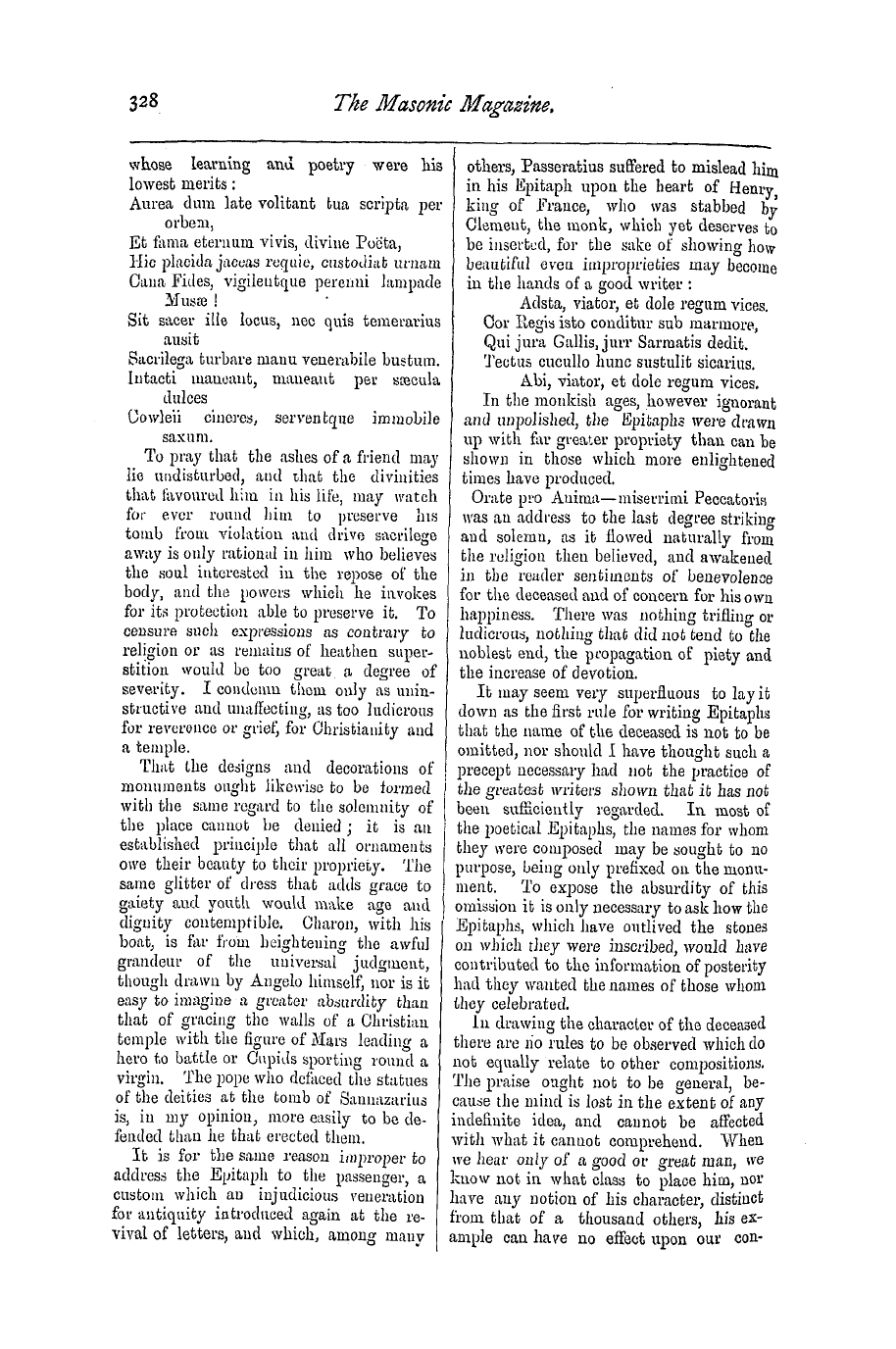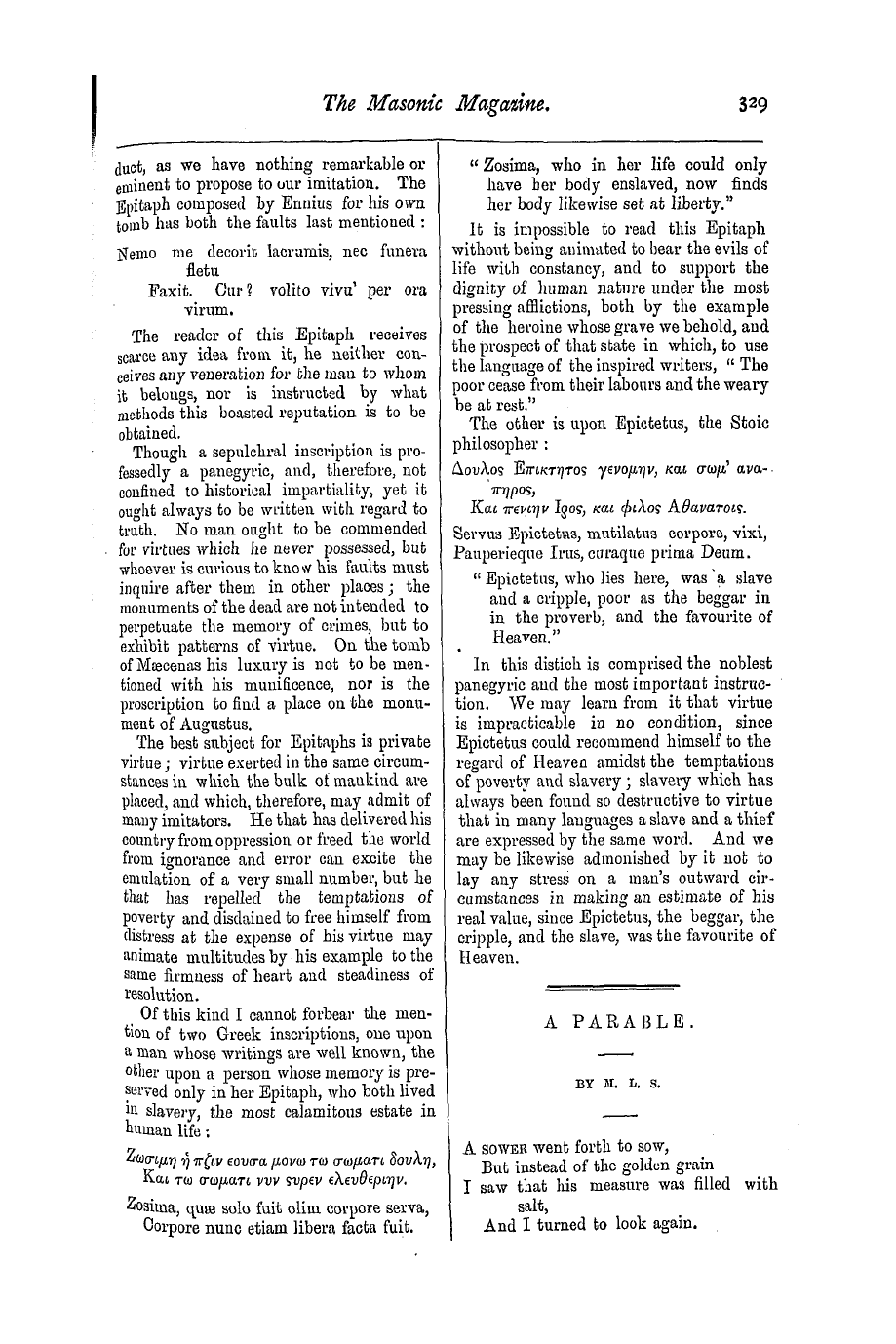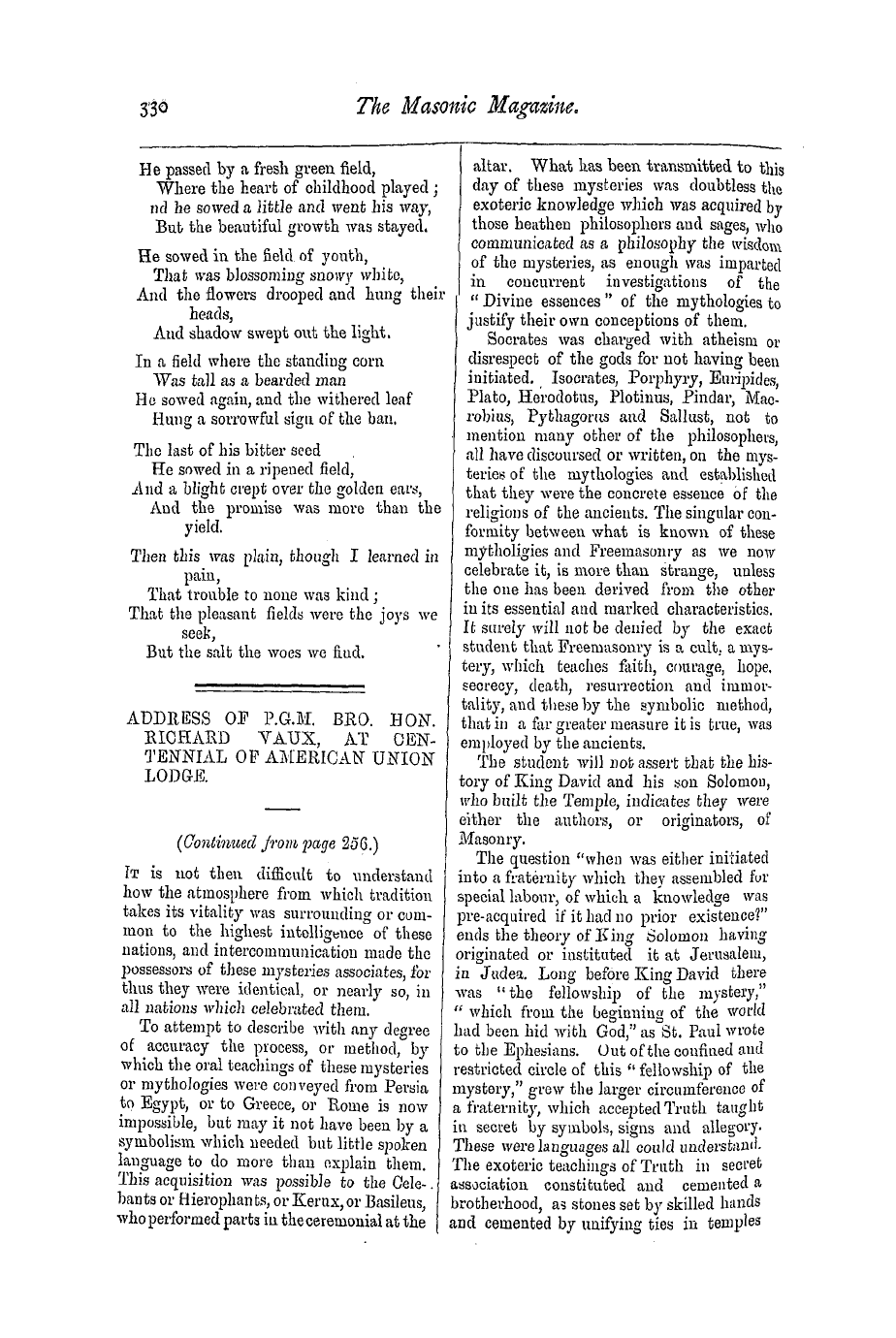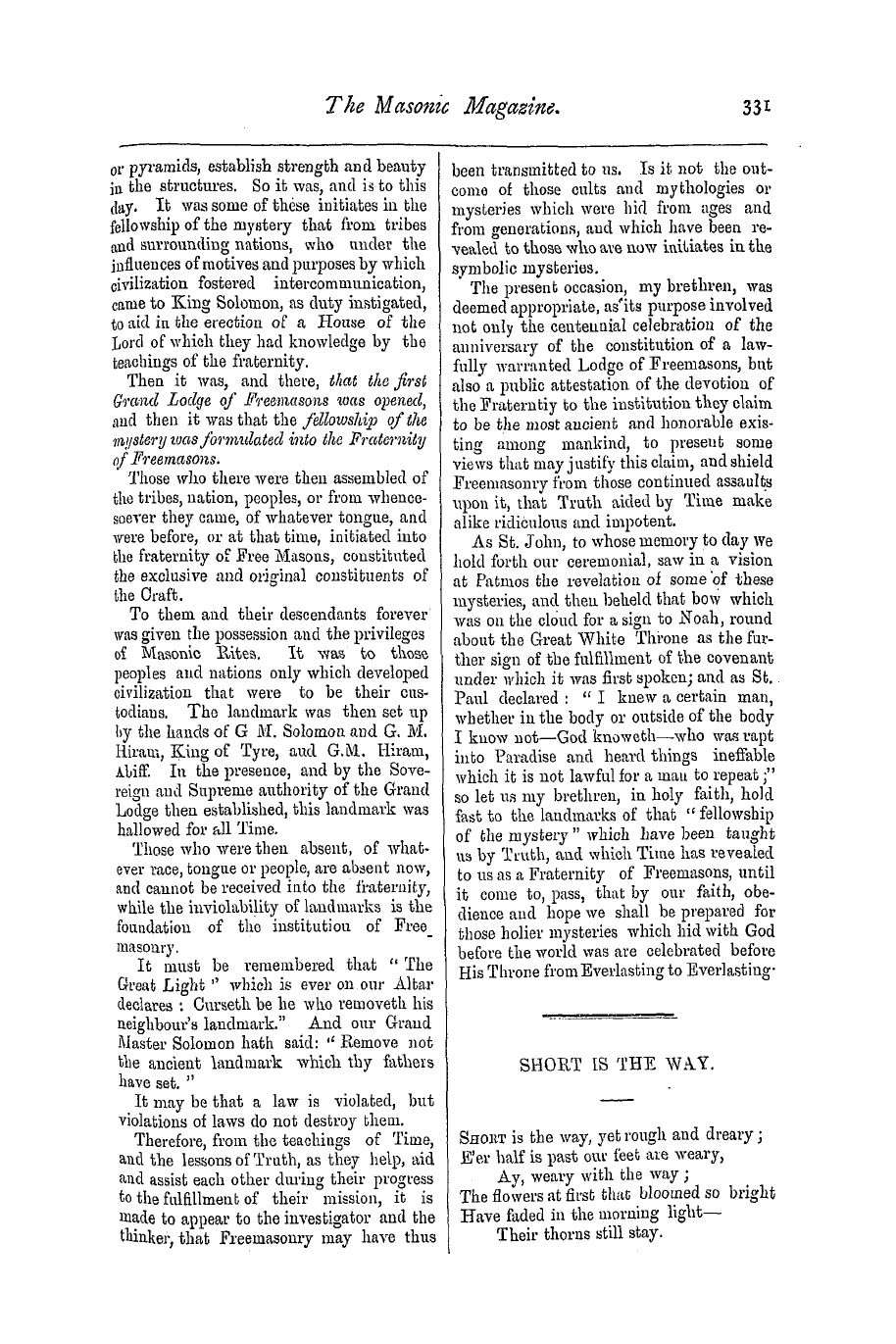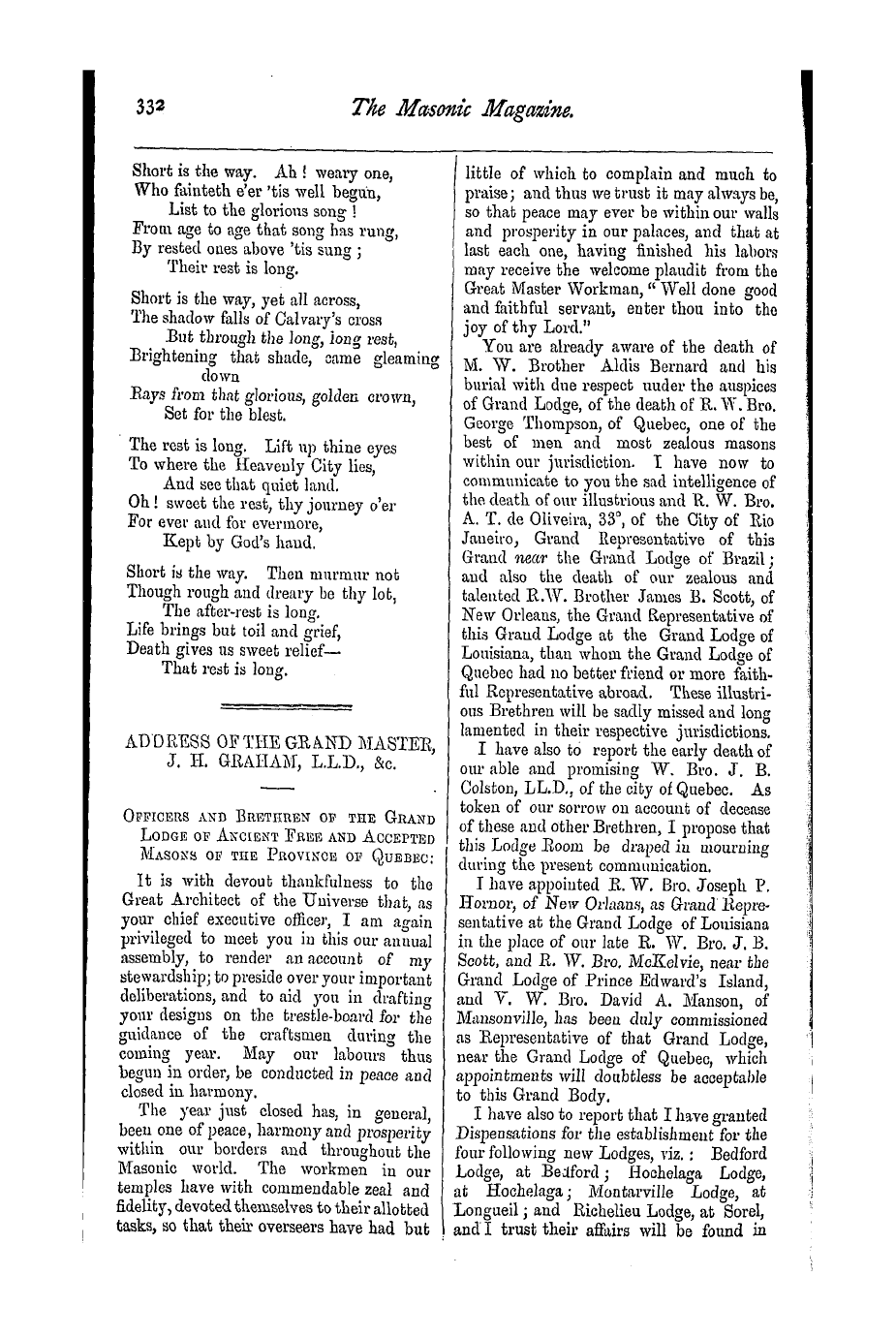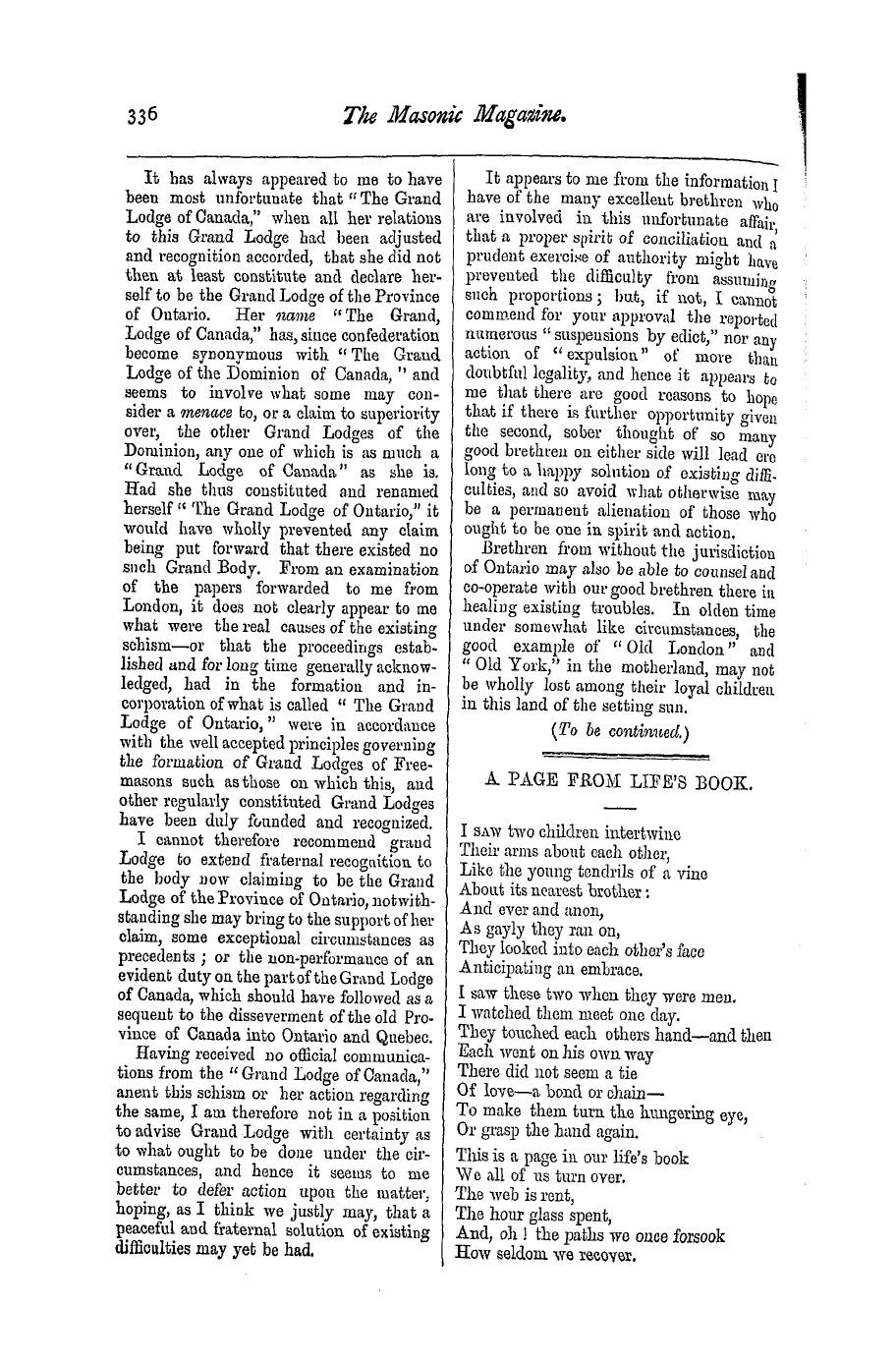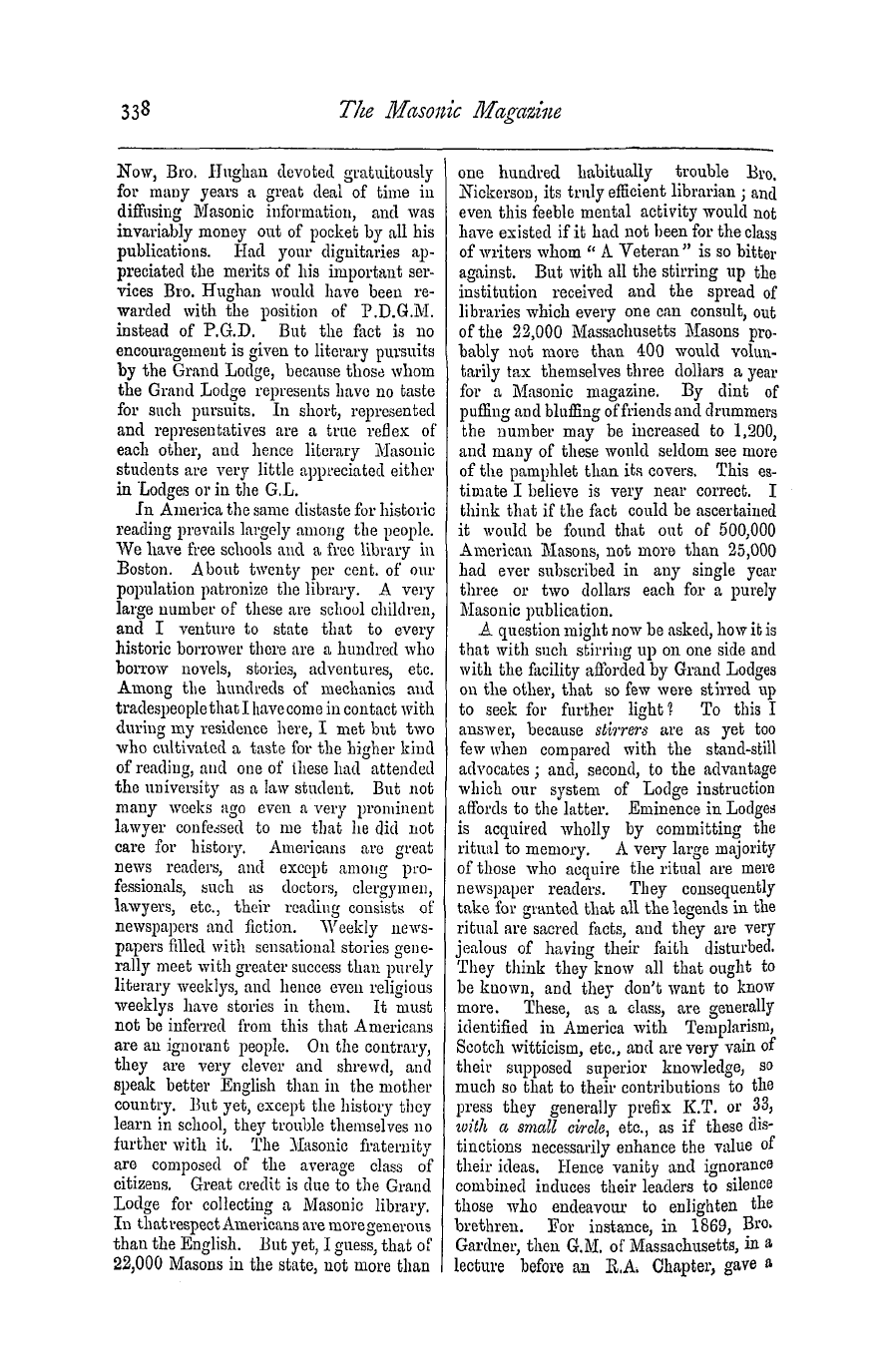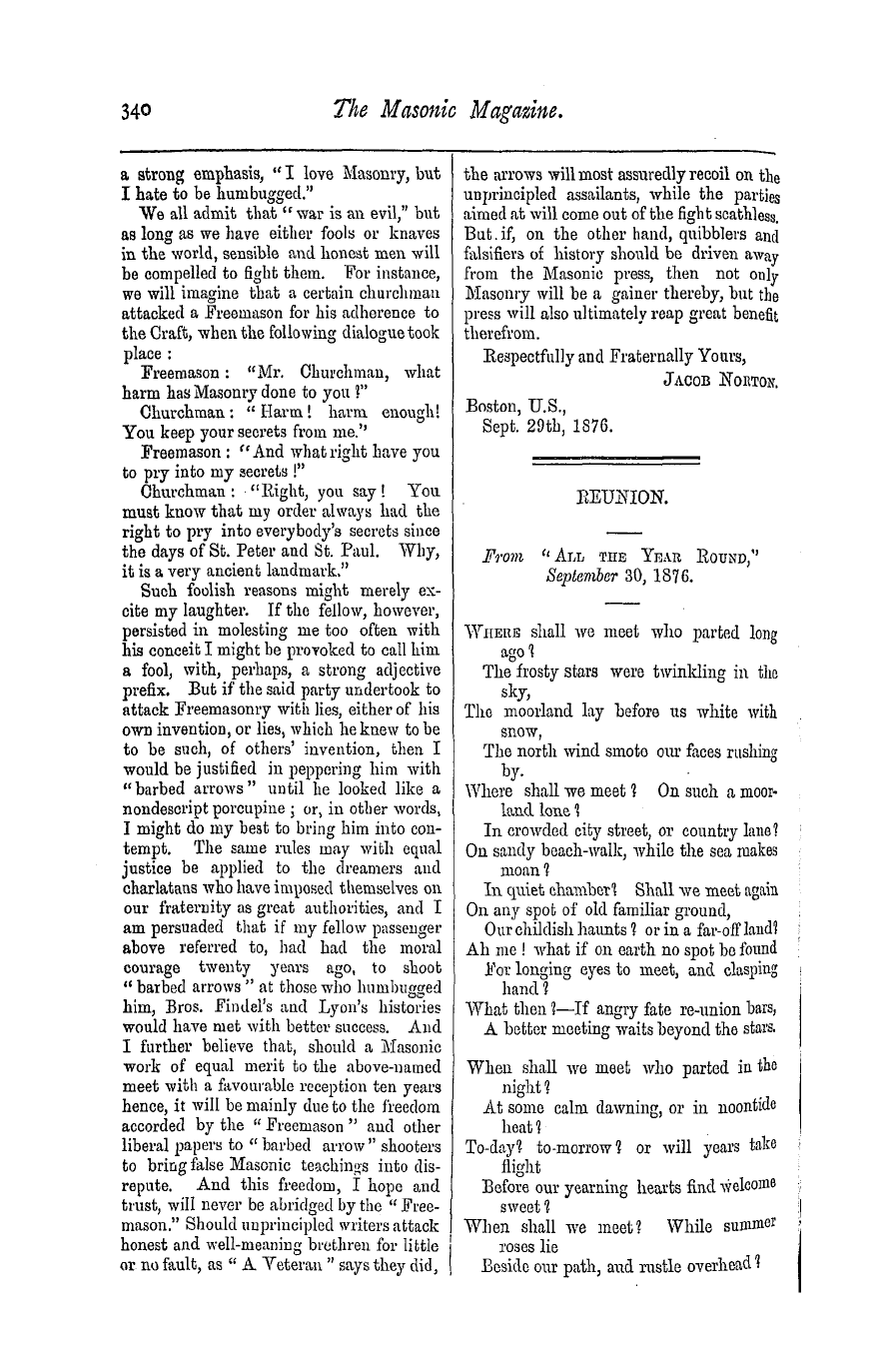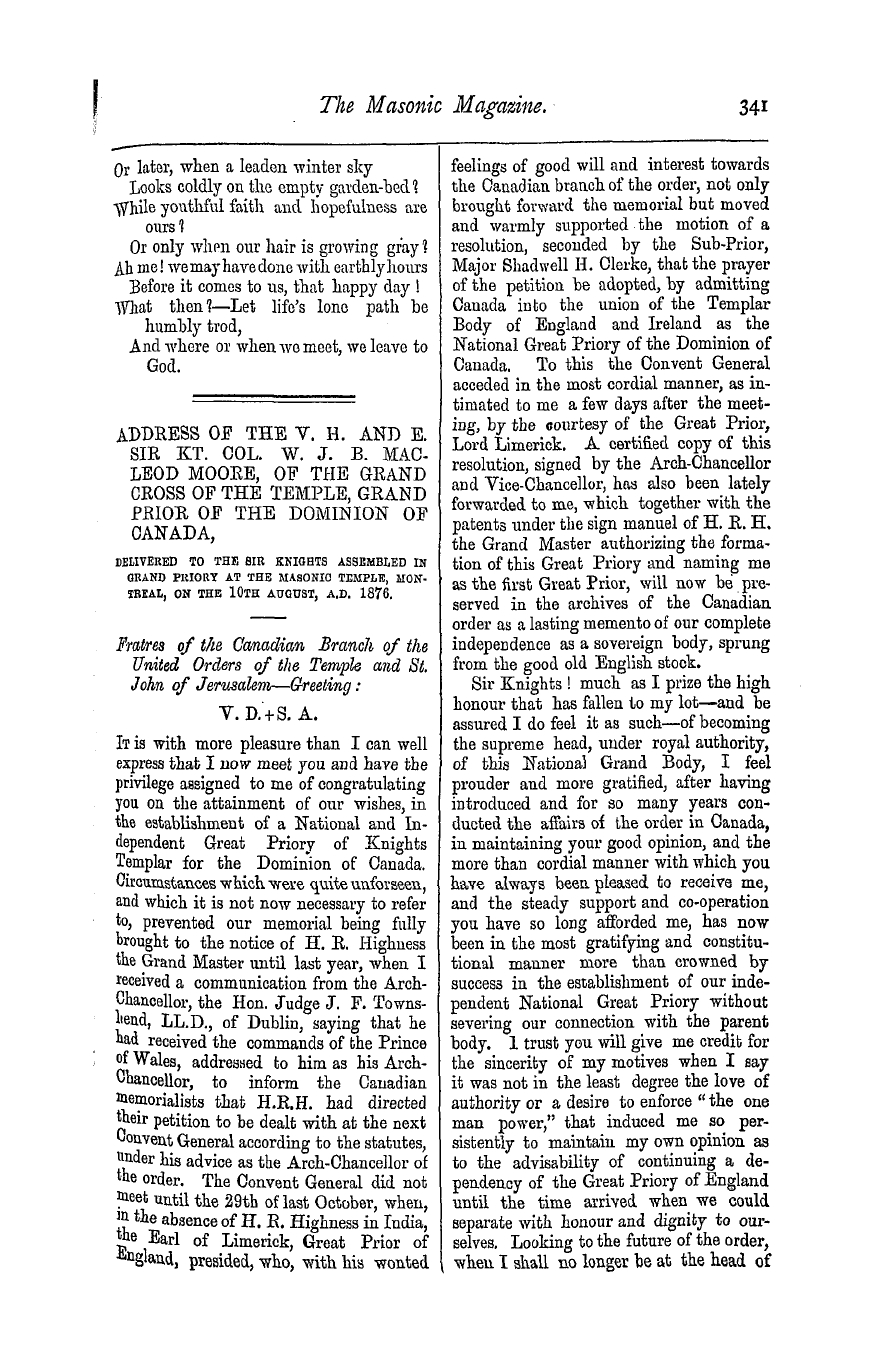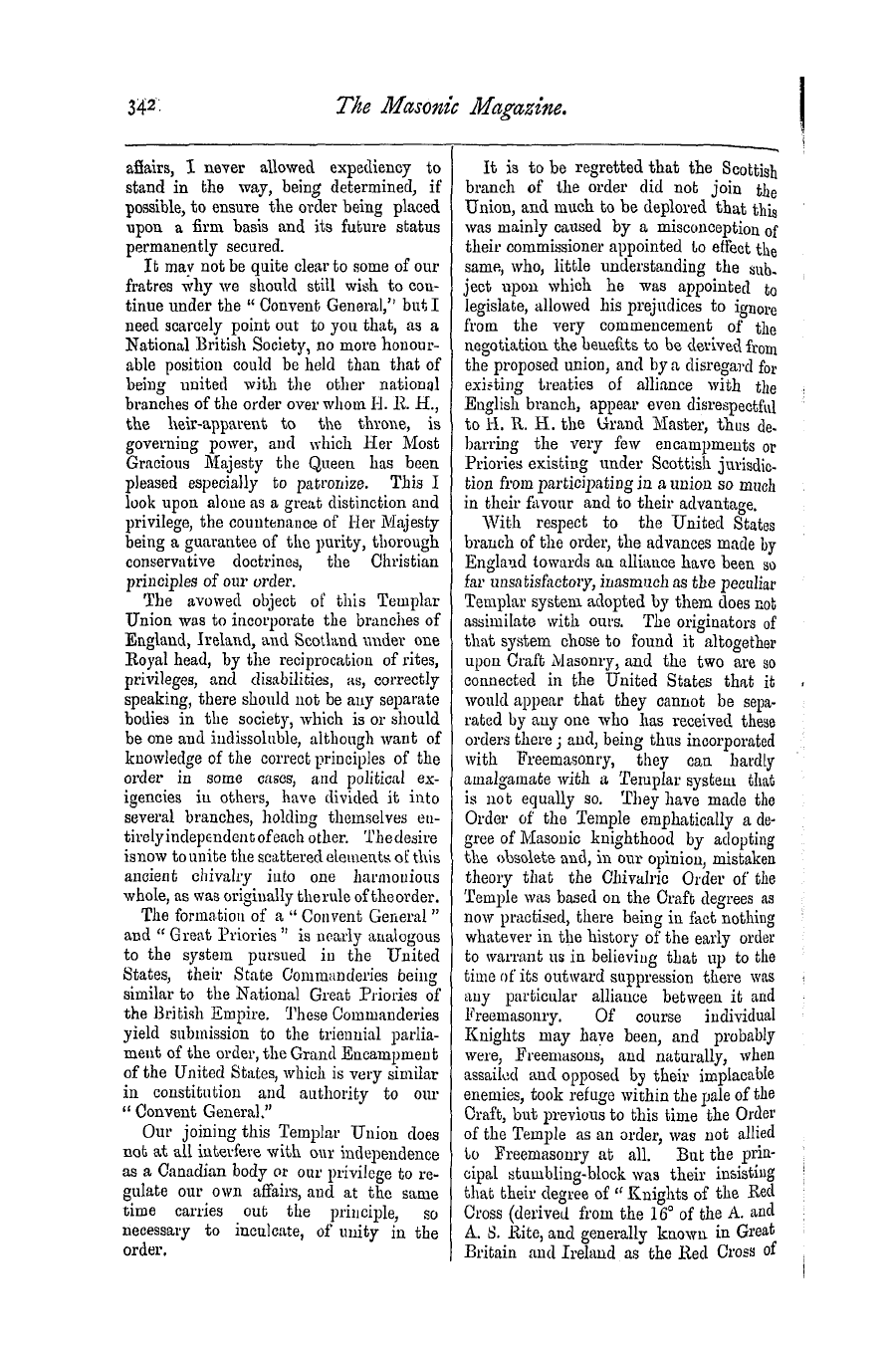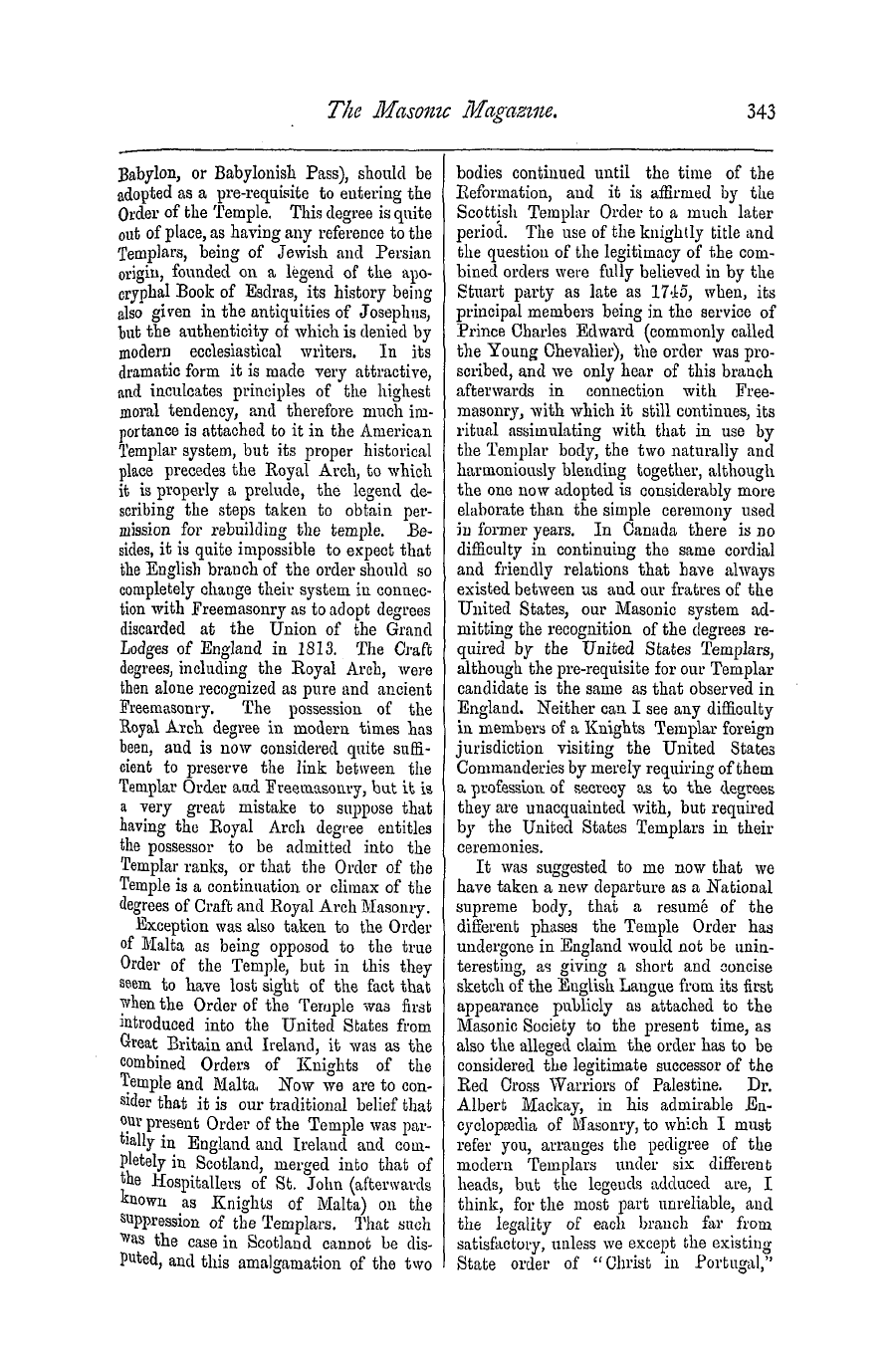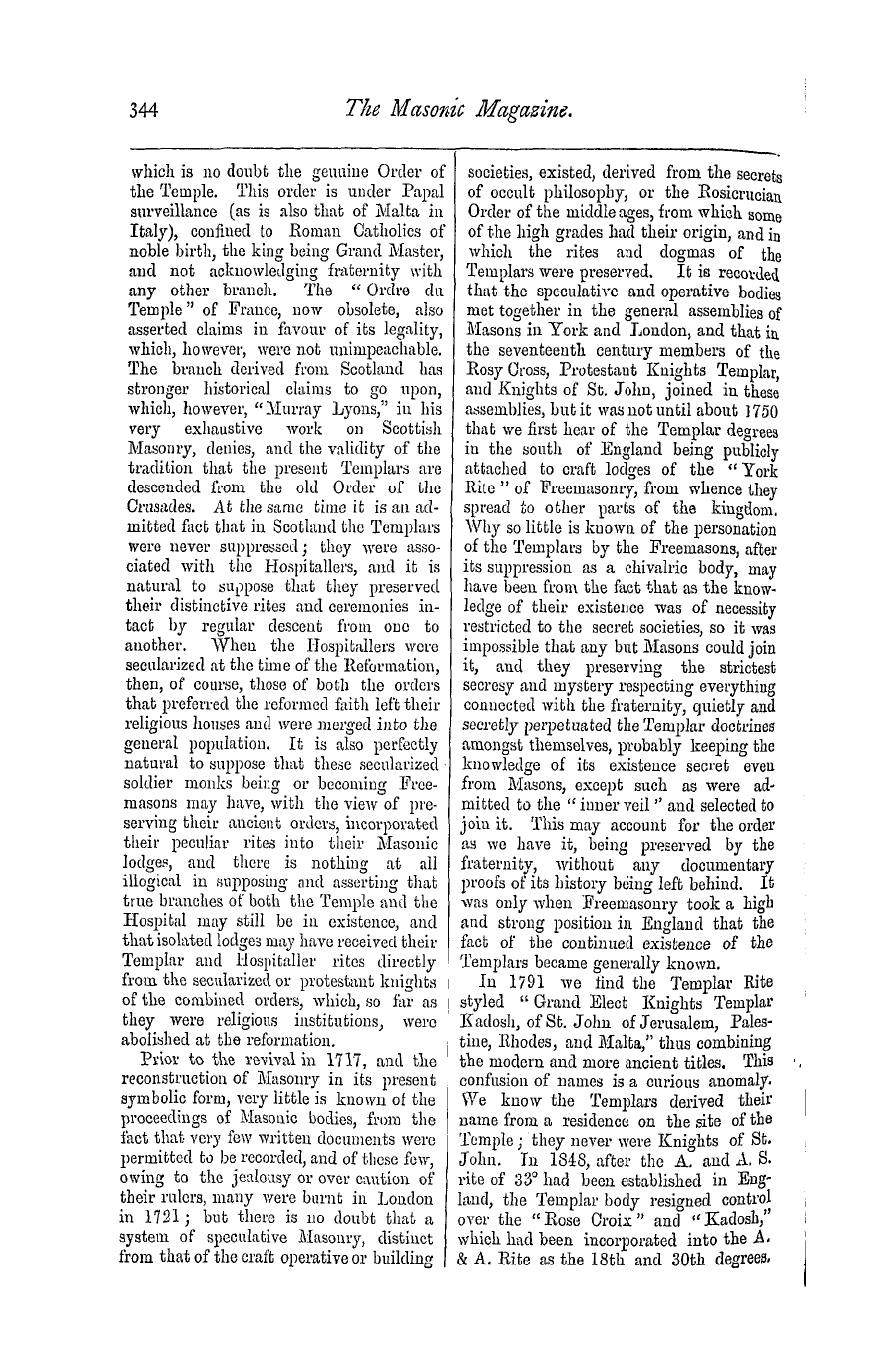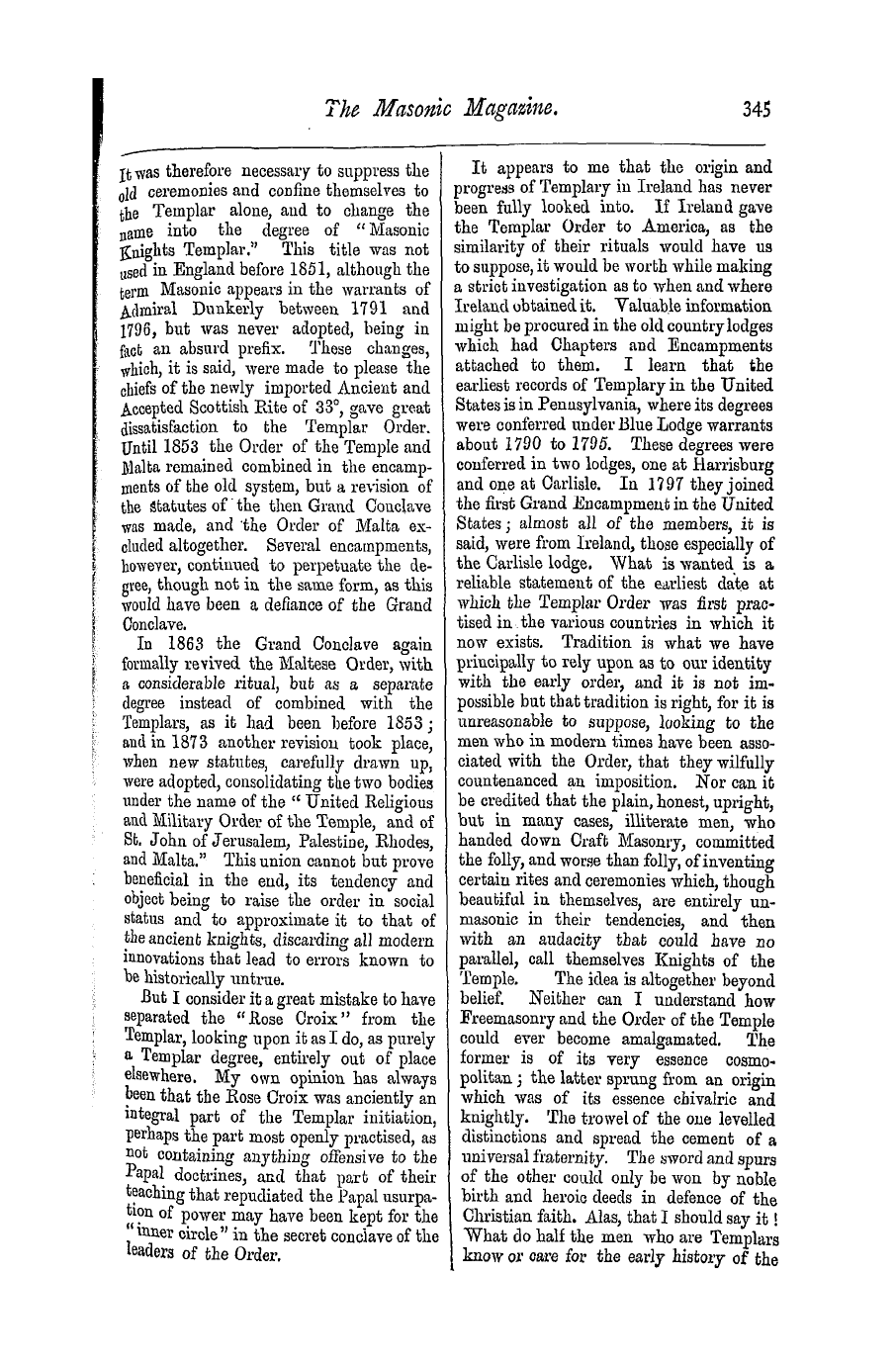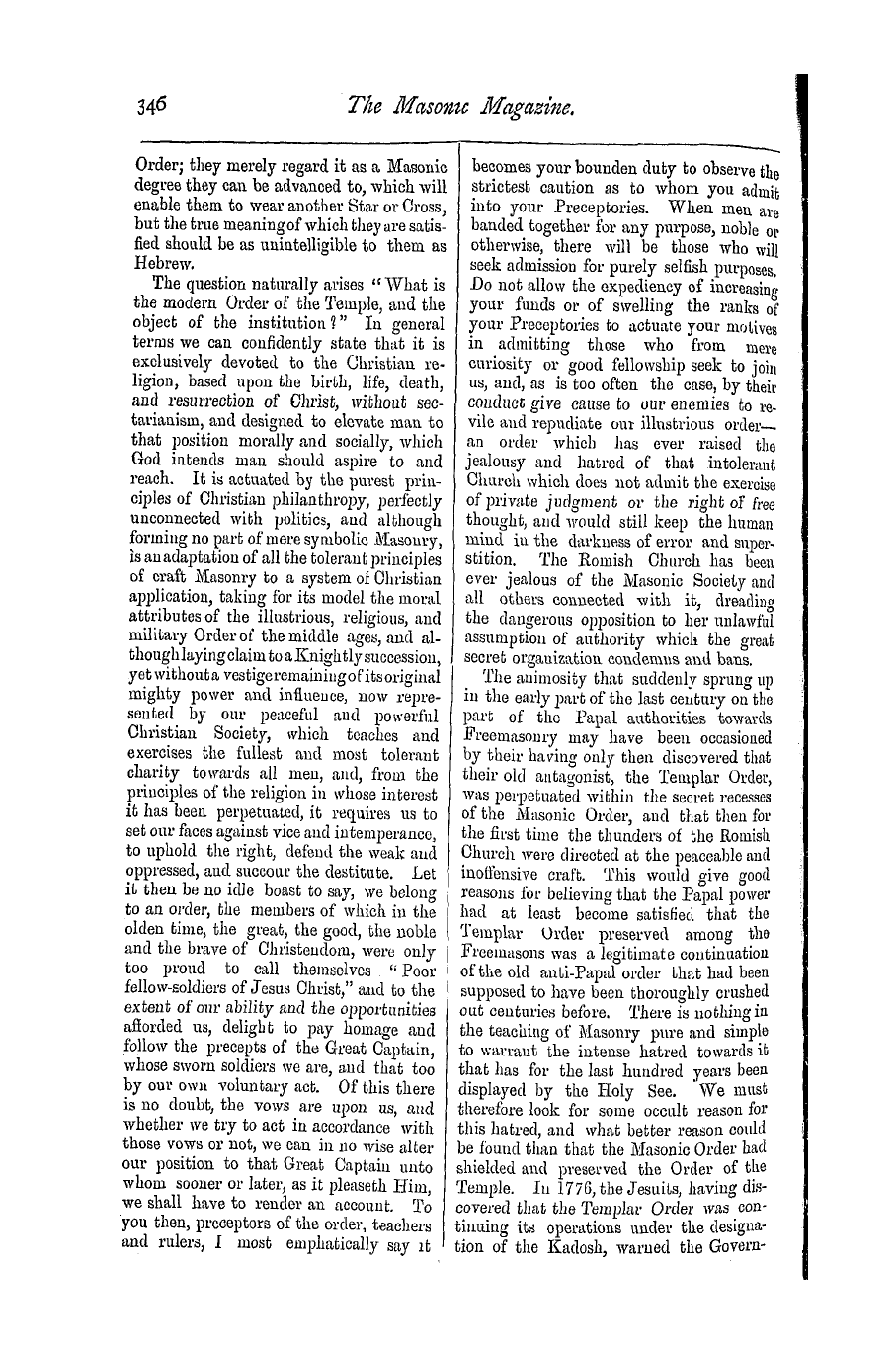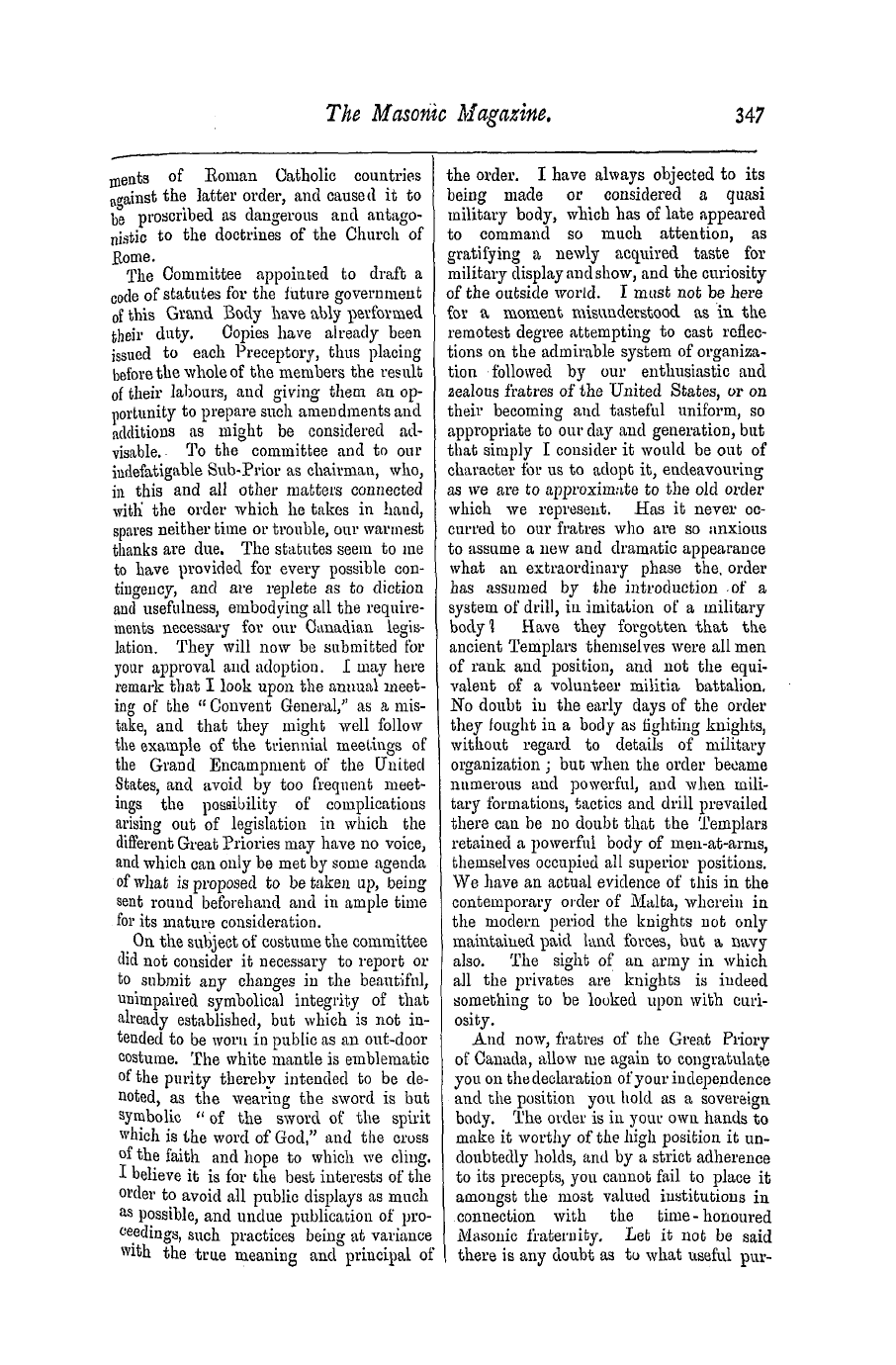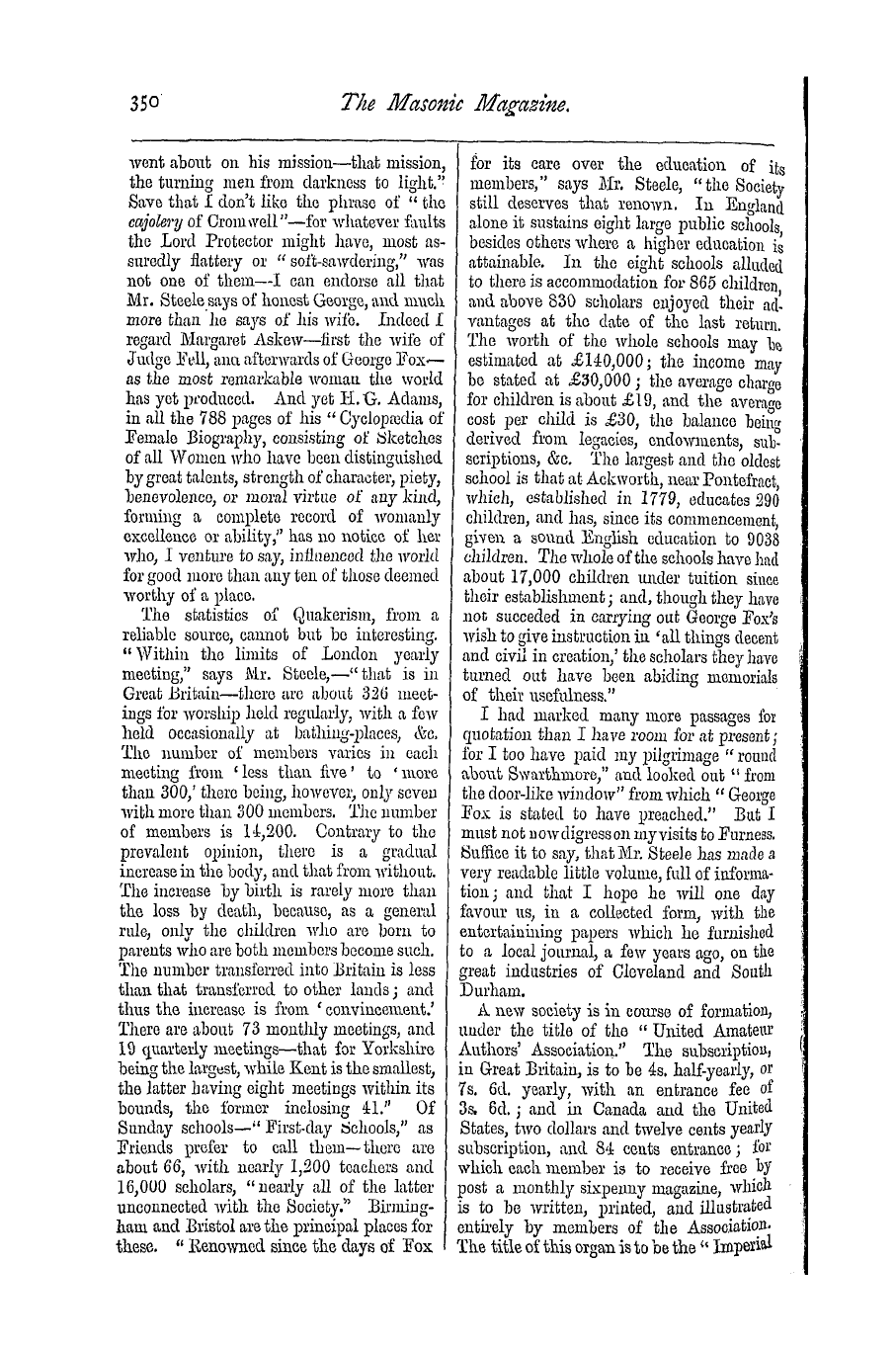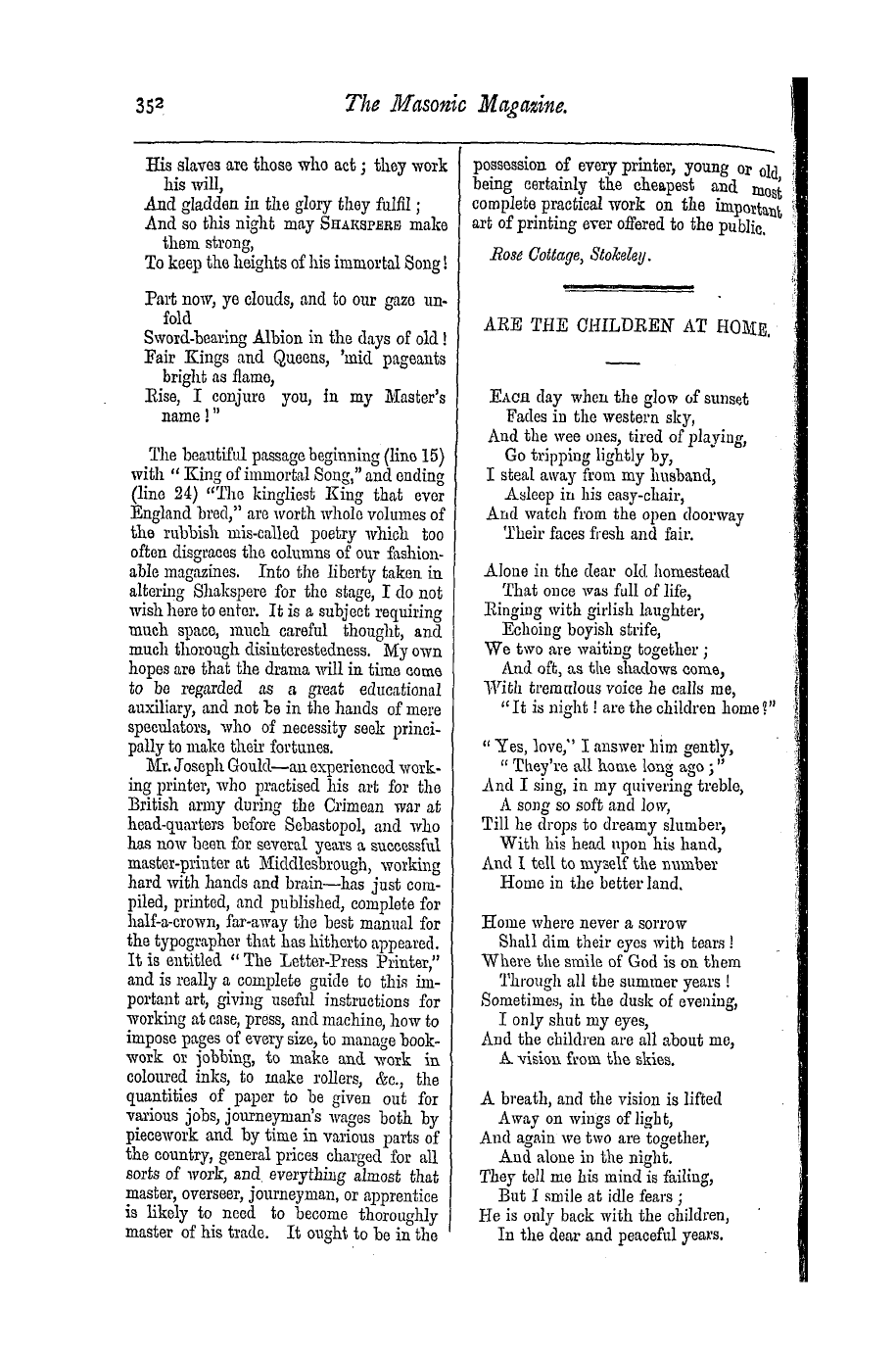Note: This text has been automatically extracted via Optical Character Recognition (OCR) software.
Address Of The V. H. And E. Sir Kt. Col. W. J. B. Macleod Moore, Of The Grand Cross Of The Temple, Grand Prior Of The Dominion Of Canada,
jt was therefore necessary to suppress the 0 ld ceremonies and confine themselves to the Templar alone , and to change the nam e into the degree of "Masonic Jnig hts Templar . " This title was not used in England before 1851 , although the
term Masonic appears in the warrants of Admiral Dunkerly between 1791 and 1796 , but was never adopted , being in fact an absurd prefix . These changes , which , it is said , were made to please the chiefs of the newly imported Ancient and
Accepted Scottish Rite of 33 ° , gave great dissatisfaction to the Templar Order . Until 1853 the Order of the Temple and Malta remained combined in the encampments of the old system , but a revision of the Statutes of the then Grand Conclave
was made , and 'the Order of Malta excluded altogether . Several encampments , however , continued to perpetuate the degree , though not in the same form , as this would have been a defiance of the Grand
Conclave . In 1863 the Grand Conclave again formally revived the Maltese Order , with a considerable ritual , but as a separate degree instead of combined with the Templars , as it had been before 1853 ;
and in 1873 another revision took place , when new statutes , carefull y drawn up , were adopted , consolidating the two bodies under the name of the " United Religious and Military Order of the Temple , and of St . John of Jerusalem , Palestine , Rhodes ,
and Malta . " This union cannot but prove beneficial in the end , its tendency and object being to raise the order in social status and to approximate it to that of the ancient knights , discarding all modern innovations that lead to errors known to
be historically untrue . But I consider it a great mistake to have separated the "Rose Croix" from the Templar , looking upon it as I do , as purely a Templar degree , entirely out of place elsewhere . My own opinion has always
been that the Rose Croix was anciently an integral part of the Templar initiation , perhaps the part most openly practised , as not containing anything offensive to the ¦ Papal doctrines , and that part of their teaching that repudiated the Papal usurpation of power may have been kept for the " inner circle" in the secret conclave of the leaders of the Order .
It appears to me that the origin and progress of Templary in Ireland has never been fully looked into . If Ireland gave the Templar Order to America , as the similarity of their rituals would have us to suppose , it would be worth while making a strict investigation as to when and where Ireland obtained it . Valuable information
might be procured m the old country lodges which had Chapters and Encampments attached to them . I learn that the earliest records of Templary in the United States is in Pennsylvania , where its degrees were conferred under Blue Lodge warrants about 1790 to 1795 . These degrees were
conferred in two lodges , one at Harrisburg and one at Carlisle . In 1797 they joined the first Grand Encampment in the United States ; almost all of the members , it is said , were from Ireland , those especially of the Carlisle lodge . What is wanted is a reliable statement of the earliest date at
which the Templar Order was first practised in the various countries in which it now exists . Tradition is what we have principally to rely upon as to our identity with the early order , and it is not impossible but that tradition is right , for it is
unreasonable to suppose , looking to the men who in modern times have been associated with the Order , that they wilfully countenanced an imposition . Nor can it be credited that the plain , honest , upright , but in many casesilliterate menwho
, , handed down Craft Masonry , committed the folly , and worse than folly , of inventing certain rites and ceremonies which , though beautiful in themselves , are entirely unmasonic in their tendencies , and then with an audacity that could have no
parallel , call themselves Knights of the Temple . The idea is altogether beyond belief . Neither can I understand how Freemasonry and the Order of the Temple could ever become amalgamated . The former is of its very essence
cosmopolitan ; the latter sprung from an ori gin which was of its essence chivalric and knightly . The trowel of the one levelled distinctions and spread the cement of a universal fraternity . The sword and spurs of the other could only be won by noble
birth and heroic deeds in defence of the Christian faith . Alas , that I should say it ! What do half the men who are Templars know or care for the earl y history of the
Note: This text has been automatically extracted via Optical Character Recognition (OCR) software.
Address Of The V. H. And E. Sir Kt. Col. W. J. B. Macleod Moore, Of The Grand Cross Of The Temple, Grand Prior Of The Dominion Of Canada,
jt was therefore necessary to suppress the 0 ld ceremonies and confine themselves to the Templar alone , and to change the nam e into the degree of "Masonic Jnig hts Templar . " This title was not used in England before 1851 , although the
term Masonic appears in the warrants of Admiral Dunkerly between 1791 and 1796 , but was never adopted , being in fact an absurd prefix . These changes , which , it is said , were made to please the chiefs of the newly imported Ancient and
Accepted Scottish Rite of 33 ° , gave great dissatisfaction to the Templar Order . Until 1853 the Order of the Temple and Malta remained combined in the encampments of the old system , but a revision of the Statutes of the then Grand Conclave
was made , and 'the Order of Malta excluded altogether . Several encampments , however , continued to perpetuate the degree , though not in the same form , as this would have been a defiance of the Grand
Conclave . In 1863 the Grand Conclave again formally revived the Maltese Order , with a considerable ritual , but as a separate degree instead of combined with the Templars , as it had been before 1853 ;
and in 1873 another revision took place , when new statutes , carefull y drawn up , were adopted , consolidating the two bodies under the name of the " United Religious and Military Order of the Temple , and of St . John of Jerusalem , Palestine , Rhodes ,
and Malta . " This union cannot but prove beneficial in the end , its tendency and object being to raise the order in social status and to approximate it to that of the ancient knights , discarding all modern innovations that lead to errors known to
be historically untrue . But I consider it a great mistake to have separated the "Rose Croix" from the Templar , looking upon it as I do , as purely a Templar degree , entirely out of place elsewhere . My own opinion has always
been that the Rose Croix was anciently an integral part of the Templar initiation , perhaps the part most openly practised , as not containing anything offensive to the ¦ Papal doctrines , and that part of their teaching that repudiated the Papal usurpation of power may have been kept for the " inner circle" in the secret conclave of the leaders of the Order .
It appears to me that the origin and progress of Templary in Ireland has never been fully looked into . If Ireland gave the Templar Order to America , as the similarity of their rituals would have us to suppose , it would be worth while making a strict investigation as to when and where Ireland obtained it . Valuable information
might be procured m the old country lodges which had Chapters and Encampments attached to them . I learn that the earliest records of Templary in the United States is in Pennsylvania , where its degrees were conferred under Blue Lodge warrants about 1790 to 1795 . These degrees were
conferred in two lodges , one at Harrisburg and one at Carlisle . In 1797 they joined the first Grand Encampment in the United States ; almost all of the members , it is said , were from Ireland , those especially of the Carlisle lodge . What is wanted is a reliable statement of the earliest date at
which the Templar Order was first practised in the various countries in which it now exists . Tradition is what we have principally to rely upon as to our identity with the early order , and it is not impossible but that tradition is right , for it is
unreasonable to suppose , looking to the men who in modern times have been associated with the Order , that they wilfully countenanced an imposition . Nor can it be credited that the plain , honest , upright , but in many casesilliterate menwho
, , handed down Craft Masonry , committed the folly , and worse than folly , of inventing certain rites and ceremonies which , though beautiful in themselves , are entirely unmasonic in their tendencies , and then with an audacity that could have no
parallel , call themselves Knights of the Temple . The idea is altogether beyond belief . Neither can I understand how Freemasonry and the Order of the Temple could ever become amalgamated . The former is of its very essence
cosmopolitan ; the latter sprung from an ori gin which was of its essence chivalric and knightly . The trowel of the one levelled distinctions and spread the cement of a universal fraternity . The sword and spurs of the other could only be won by noble
birth and heroic deeds in defence of the Christian faith . Alas , that I should say it ! What do half the men who are Templars know or care for the earl y history of the



































































